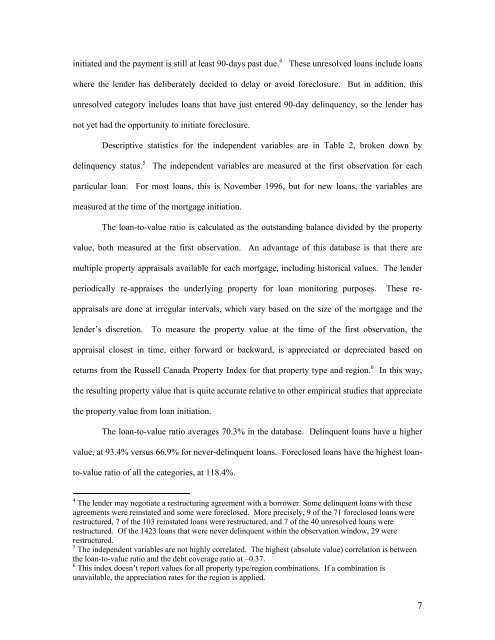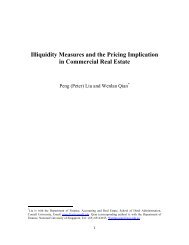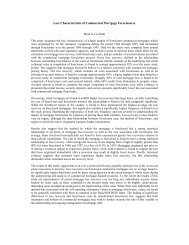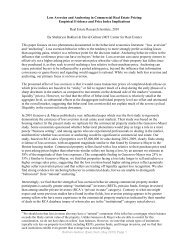Commercial Mortgage Delinquency, Foreclosure and Reinstatement
Commercial Mortgage Delinquency, Foreclosure and Reinstatement
Commercial Mortgage Delinquency, Foreclosure and Reinstatement
You also want an ePaper? Increase the reach of your titles
YUMPU automatically turns print PDFs into web optimized ePapers that Google loves.
initiated <strong>and</strong> the payment is still at least 90-days past due. 4These unresolved loans include loanswhere the lender has deliberately decided to delay or avoid foreclosure. But in addition, thisunresolved category includes loans that have just entered 90-day delinquency, so the lender hasnot yet had the opportunity to initiate foreclosure.Descriptive statistics for the independent variables are in Table 2, broken down bydelinquency status. 5The independent variables are measured at the first observation for eachparticular loan. For most loans, this is November 1996, but for new loans, the variables aremeasured at the time of the mortgage initiation.The loan-to-value ratio is calculated as the outst<strong>and</strong>ing balance divided by the propertyvalue, both measured at the first observation. An advantage of this database is that there aremultiple property appraisals available for each mortgage, including historical values. The lenderperiodically re-appraises the underlying property for loan monitoring purposes. These reappraisalsare done at irregular intervals, which vary based on the size of the mortgage <strong>and</strong> thelender’s discretion. To measure the property value at the time of the first observation, theappraisal closest in time, either forward or backward, is appreciated or depreciated based onreturns from the Russell Canada Property Index for that property type <strong>and</strong> region. 6In this way,the resulting property value that is quite accurate relative to other empirical studies that appreciatethe property value from loan initiation.The loan-to-value ratio averages 70.3% in the database. Delinquent loans have a highervalue, at 93.4% versus 66.9% for never-delinquent loans. Foreclosed loans have the highest loanto-valueratio of all the categories, at 118.4%.4 The lender may negotiate a restructuring agreement with a borrower. Some delinquent loans with theseagreements were reinstated <strong>and</strong> some were foreclosed. More precisely, 9 of the 71 foreclosed loans wererestructured, 7 of the 103 reinstated loans were restructured, <strong>and</strong> 7 of the 40 unresolved loans wererestructured. Of the 1423 loans that were never delinquent within the observation window, 29 wererestructured.5 The independent variables are not highly correlated. The highest (absolute value) correlation is betweenthe loan-to-value ratio <strong>and</strong> the debt coverage ratio at –0.37.6 This index doesn’t report values for all property type/region combinations. If a combination isunavailable, the appreciation rates for the region is applied.7





